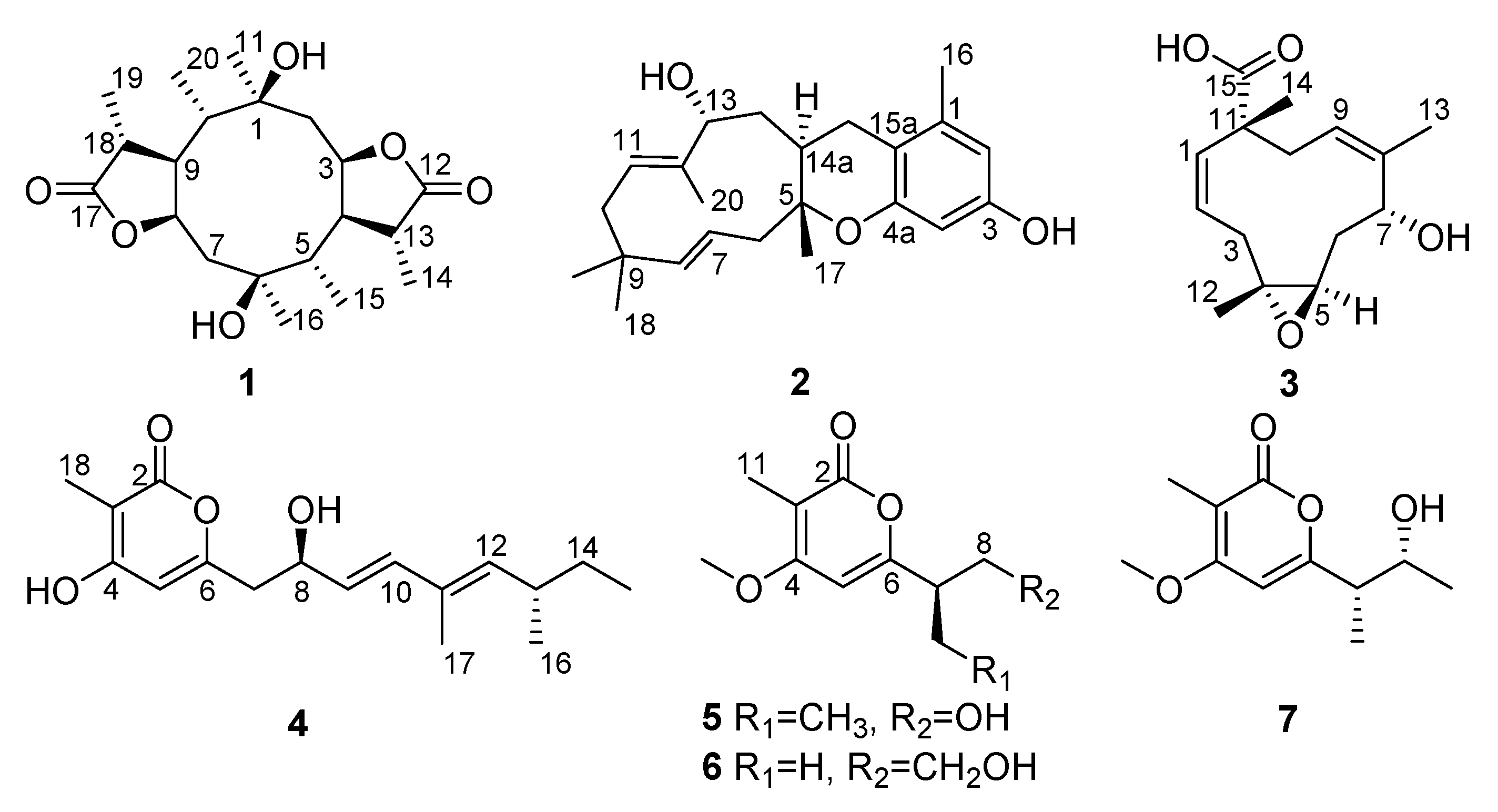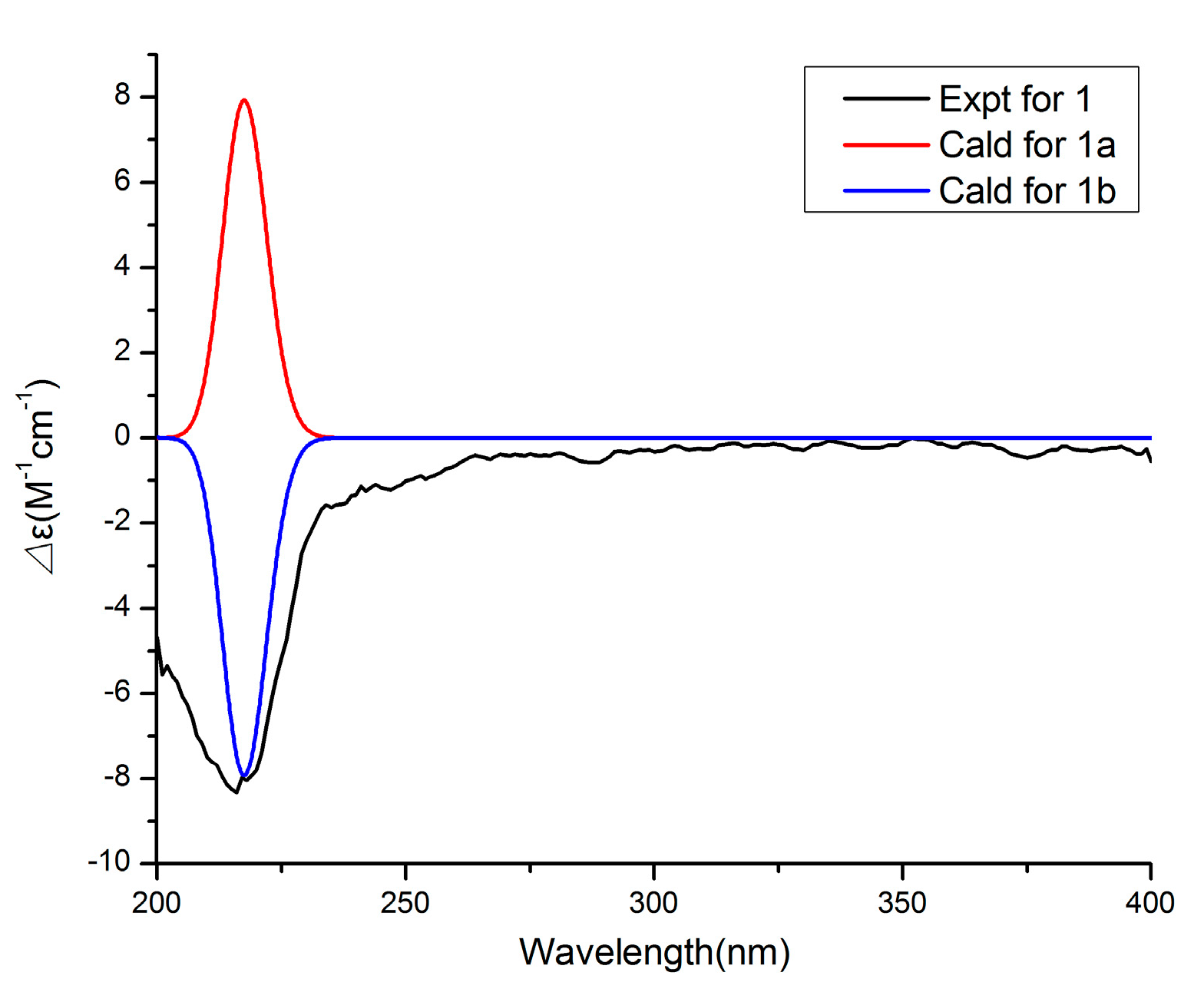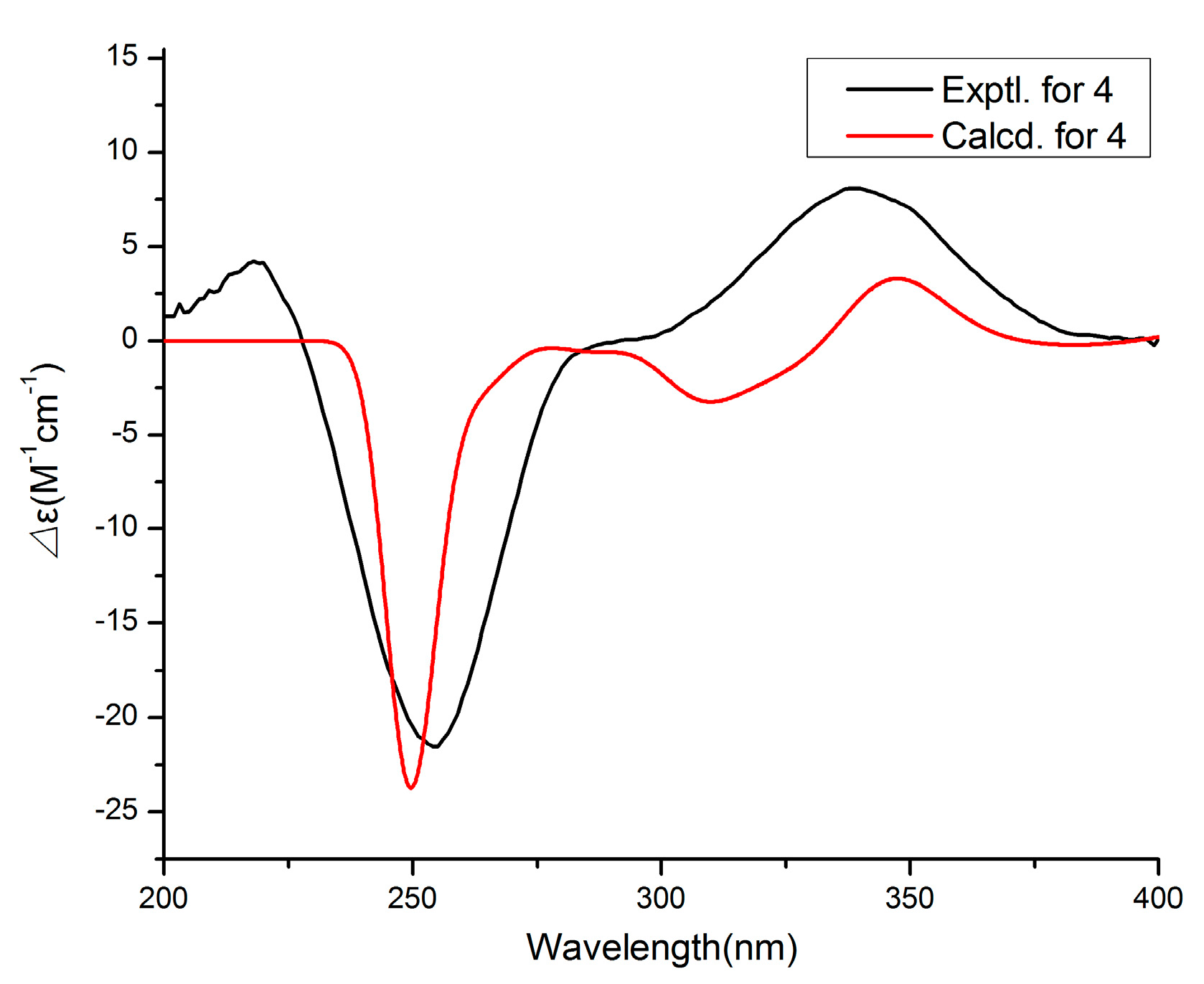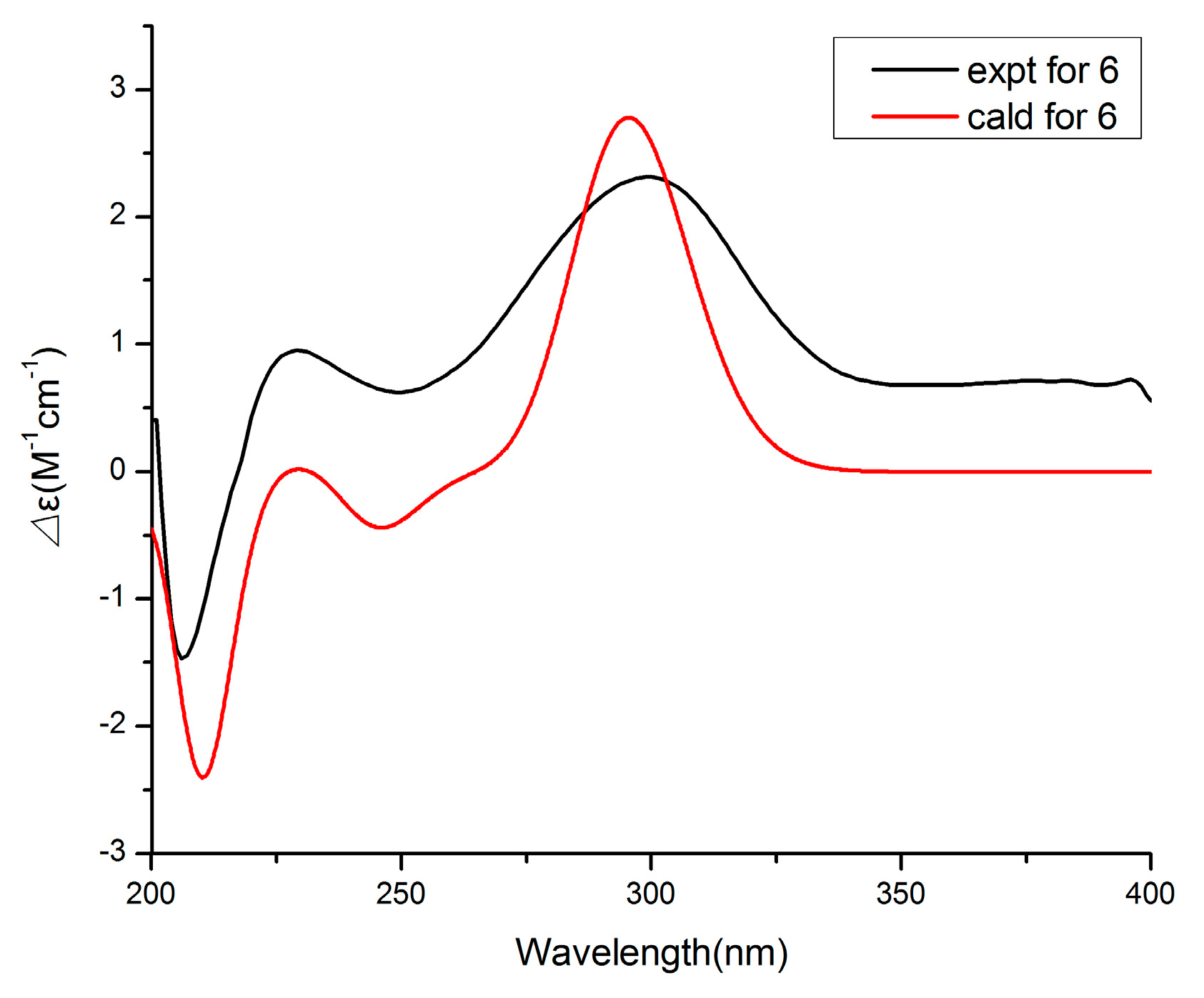Metabolites with Anti-Inflammatory Activity from the Mangrove Endophytic Fungus Diaporthe sp. QYM12
Abstract
1. Introduction
2. Results
3. Experimental Section
3.1. General Experimental Procedures
3.2. Fungal Material, Fermentation and Isolation
3.3. ECD Calculation Methods
3.4. Anti-Inflammatory Assay
4. Conclusions
Supplementary Materials
Author Contributions
Funding
Institutional Review Board Statement
Data Availability Statement
Conflicts of Interest
References
- Cheng, Z.S.; Pan, J.H.; Tang, W.C.; Chen, Q.J.; Lin, Y.C. Biodiversity and biotechnological potential of mangrove-associated fungi. J. For. Res. 2009, 20, 63–72. [Google Scholar] [CrossRef]
- Sebastianes, F.L.S.; Cabedo, N.; Aouad, N.E. 3-Hydroxypropionic Acid as an Antibacterial Agent from Endophytic Fungi Diaporthe phaseolorum. Curr. Microbiol. 2012, 65, 622–632. [Google Scholar] [CrossRef] [PubMed]
- Zhu, F.; Lin, Y.C. Marinamide, a novel alkaloid and its methyl ester produced by the application of mixed fermentation technique to two mangrove endophytic fungi from the South China Sea. Chin. Sci. Bull. 2006, 51, 1426–1430. [Google Scholar] [CrossRef]
- Rosario, N.; Maria, S.; Anna, A. Secondary Metabolites of Mangrove-Associated Strains of Talaromyces. Mar. Drugs 2018, 16, 12. [Google Scholar]
- Deshmukh, S.K.; Gupta, M.K.; Prakash, V. Mangrove-Associated Fungi: A Novel Source of Potential Anticancer Compounds. J. Fungi 2018, 4, 101. [Google Scholar] [CrossRef]
- Carvalho, C.R.D.; Ferreira-D’Silva, A.; Wedge, D.E. Antifungal activities of cytochalasins produced by Diaporthe miriciae, an endophytic fungus associated with tropical medicinal plants. Can. J. Microbiol. 2018, 64, 835–843. [Google Scholar] [CrossRef]
- Sousa, J.P.B.; Aguilar-Pérez, M.M.; Arnold, A.E. Chemical constituents and their antibacterial activity from the tropical endophytic fungus Diaporthe sp. F2934. J. Appl. Microbiol. 2016, 120, 1501–1508. [Google Scholar] [CrossRef][Green Version]
- Yang, X.; Wu, P.; Xue, J. Cytochalasans from endophytic fungus Diaporthe sp. SC-J0138. Fitoterapia 2020, 145, 104611. [Google Scholar] [CrossRef]
- Dettrakul, S.; Kittakoop, P.; Isaka, M. Antimycobacterial pimarane diterpenes from the Fungus Diaporthe sp. Bioorg. Med. Chem. Lett. 2003, 13, 1253–1255. [Google Scholar] [CrossRef]
- Chepkirui, C.; Stadler, M. The genus Diaporthe: A rich source of diverse and bioactive metabolites. Mycol. Prog. 2017, 16, 477–494. [Google Scholar] [CrossRef]
- Kumaran, R.S.; Hur, B.K. Screening of species of the endophytic fungus Phomopsis for the production of the anticancer drug taxol. Biotechnol. Appl. Bioc. 2011, 54, 21–30. [Google Scholar] [CrossRef] [PubMed]
- Du, Y.; Sun, J.; Gong, Q. New α-Pyridones with Quorum Sensing Inhibitory Activity from Diversity-Enhanced Extracts of a Marine Algae-Derived Streptomyces sp. J. Agric. Food Chem. 2018, 66, 1807–1812. [Google Scholar] [CrossRef] [PubMed]
- Pittayakhajonwut, P.; Theerasilp, M.; Kongsaeree, P.; Pughiinin, A. A Sesquiterpene from the Fungus Kionochaeta pughii BCC 3878. Planta Med. 2002, 68, 1017–1019. [Google Scholar] [CrossRef] [PubMed]
- Cai, P.; Smith, D.; Cunningham, B. Epolones: Novel Sesquiterpene-Tropolones from Fungus OS-F69284 That Induce Erythropoietin in Human Cells. J. Nat. Prod. 1998, 61, 791–795. [Google Scholar] [CrossRef] [PubMed]
- Chiang, Y.M.; Oakley, C.E.; Ahuia, M. An efficient system for heterologous expression of secondary metabolite genes in Aspergillus nidulans. J. Am. Chem. Soc. 2013, 135, 7720–7731. [Google Scholar] [CrossRef] [PubMed]
- Zhang, H.; Saurav, K.; Yu, Z. alpha-Pyrones with Diverse Hydroxy Substitutions from Three Marine-Derived Nocardiopsis Strains. J. Nat. Prod. 2016, 79, 1610–1618. [Google Scholar] [CrossRef] [PubMed]
- Aoki, Y.; Matsumoto, D.; Kawaide, H. Physiological role of germicidins in spore germination and hyphal elongation in Streptomyces coelicolor A3(2). J. Antibiot. 2011, 64, 607–611. [Google Scholar] [CrossRef]
- Weber, D.; Gorzalczany, S.; Martino, V. Metabolites from Endophytes of the Medicinal Plant Erythrina crista-galli. Z. Naturforsch. C. Biosci. 2005, 60, 5–6. [Google Scholar] [CrossRef]
- Iadecola, C.; Pelligrino, D.A.; Moskowitz, M.A. Nitric oxide synthase inhibition and cerebrovascular regulation. J. Cereb. Blood Flow Metab. 1994, 14, 175–192. [Google Scholar] [CrossRef]
- Chen, Y.; Liu, Z.M.; Liu, H.J. Dichloroisocoumarins with Potential Anti-Inflammatory Activity from the Mangrove Endophytic Fungus Ascomycota sp. CYSK-4. Mar. Drugs 2018, 16, 54. [Google Scholar] [CrossRef]
- Chen, Y.; Liu, Z.M.; She, Z.G. Ascomylactams A-C, Cytotoxic 12- or 13-Membered-Ring Macrocyclic Alkaloids Isolated from the Mangrove Endophytic Fungus Didymella sp. CYSK-4, and Structure Revisions of Phomapyrrolidones A and C. J. Nat. Prod. 2019, 82, 1752–1758. [Google Scholar] [CrossRef] [PubMed]
- Thomas, B.; Robert, K.; Bernhard, L. Production of Macrocyclic Sesqui- and Diterpenes in Heterologous Microbial Hosts: A Systems Approach to Harness Nature’s Molecular Diversity. Chemcatchem 2014, 6, 1142–1165. [Google Scholar]
- Wu, J.R.; Li, X.D.; Lin, W.H. Briarane-type diterpenoids from a gorgonian coral Ellisella sp. with anti-HBV activities. Bioorg. Chem. 2020, 105, 104423. [Google Scholar] [CrossRef] [PubMed]
- Tseng, W.-R.; Ahmed, A.F.; Huang, C.-Y.; Tsai, Y.-Y.; Tai, C.-J.; Orfali, R.S.; Hwang, T.-L.; Wang, Y.-H.; Dai, C.-F.; Sheu, J.-H. Bioactive Capnosanes and Cembranes from the Soft Coral Klyxum flaccidum. Mar. Drugs 2019, 17, 461. [Google Scholar] [CrossRef] [PubMed]
- Chang, Y.C.; Chiang, C.C.; Chang, Y.S.; Chen, J.J. Novel Caryophyllane-Related Sesquiterpenoids with Anti-Inflammatory Activity from Rumphella antipathes (Linnaeus, 1758). Mar. Drugs 2020, 18, 554. [Google Scholar] [CrossRef]
- Zhou, B.; Wu, Y.; Yue, J.M. Euphorbesulins A–P, Structurally Diverse Diterpenoids from Euphorbia esula. J. Nat. Prod. 2016, 79, 1952–1961. [Google Scholar] [CrossRef]
- Lee, S.J.; Lee, I.S.; Mar, W. Inhibition of inducible nitric oxide synthase and cyclooxygenase-2 activity by 1,2,3,4,6-penta-O-galloyl-beta-D-glucose in murine macrophage cells. Arch. Pharm. Res. 2003, 26, 832–839. [Google Scholar] [CrossRef]







| No. | 1 | 2 | ||
|---|---|---|---|---|
| δC, Type | δH (J in Hz) | δC, Type | δH (J in Hz) | |
| 1 | 80.9, C | 137.8, C | ||
| 2 | 46.4, CH2 | 2.16, m | 108.9, CH | 6.26, d (2.2) |
| 3 | 81.5, CH | 4.95, td (2.5, 7.3) | 154.4, C | |
| 4 | 54.1, CH | 2.16, m | 101.4, CH | 6.18, d (2.3) |
| 4a | 154.5, C | |||
| 5 | 50.6, CH | 1.96, dt (6.8, 13.2) | 79.4, C | |
| 6α | 81.2, C | 42.8, CH2 | 2.51, d (14.5) | |
| 6β | 2.22, m | |||
| 7 | 46.0, CH2 | 2.21, m | 121.3, CH | 5.14, m |
| 2.05, m | ||||
| 8 | 81.0, CH | 4.86, td (2.5, 6.8) | 141.4, CH | 5.15, d (2.2) |
| 9 | 49.6, CH | 2.56, dt (7.2, 10.0) | 38.5, C | |
| 10 | 44.0, CH | 2.05, m | 40.6, CH2 | 2.23, m |
| 1.77, m | ||||
| 11 | 23.7, CH3 | 1.20, s | 123.5, CH | 5.17, m |
| 12 | 181.1, C | 138.6, C | ||
| 13 | 42.6, CH | 2.72, qd (3.1, 7.6) | 78.2, CH | 3.99, d (9.6) |
| 14α | 18.3, CH3 | 1.33, d (7.6) | 39.7, CH2 | 1.76, m |
| 14β | 1.11, dd (9.3, 13.5) | |||
| 14a | 34.2, CH | 1.69, m | ||
| 15α | 15.9, CH3 | 0.97, d (7.3) | 27.3, CH2 | 2.88, dd (5.6, 16.4) |
| 15β | 2.24, m | |||
| 15a | 112.7, C | |||
| 16 | 23.8, CH3 | 1.22, s | 19.3, CH3 | 2.19, s |
| 17 | 180.5, C | 19.8, CH3 | 1.06, s | |
| 18 | 38.3, CH | 2.90, dq (7.3, 9.9) | 24.1, CH3 | 1.01, s |
| 19 | 11.6, CH3 | 1.31, d (7.3) | 30.4, CH3 | 1.06, s |
| 20 | 15.8, CH3 | 0.99, d (7.2) | 10.6, CH3 | 1.65, s |
| No. | 3 | 4 | |||
|---|---|---|---|---|---|
| δC, Type | δH (J in Hz) | No. | δC, Type | δH (J in Hz) | |
| 1 | 138.8, CH | 5.50, d (15.8) | 2 | 167.7, C | |
| 2 | 124.6, CH | 5.45, ddd (4.7, 10.6, 15.8) | 3 | 97.8, C | |
| 3α | 44.1, CH2 | 2.60, dd (4.7, 11.9) | 4 | 166.4, C | |
| 3β | 1.57, dd (10.6, 11.9) | 5 | 101.7, CH | 6.06, s | |
| 4 | 64.6, C | 6 | 160.0, C | ||
| 5 | 60.7, CH | 2.45, dd (5.2, 9.7) | 7 | 41.4, CH2 | 2.65, m |
| 6α | 34.4, CH2 | 2.19, ddd (5.1, 10.0, 13.3) | 8 | 69.8, CH | 4.47, d (6.5) |
| 6β | 1.61, m | 9 | 127.7, CH | 5.58, dd (6.8, 15.6) | |
| 7 | 76.4, CH | 4.10, dd (6.6, 10.1) | 10 | 135.8, CH | 6.25, d (15.6) |
| 8 | 137.3, C | 11 | 131.6, C | ||
| 9 | 126.5, CH | 5.16, brd (11.4) | 12 | 139.6, CH | 5.23, d (10.0) |
| 10α | 36.4, CH2 | 2.71, dd (12.2, 13.3) | 13 | 34.2, CH | 2.40, m |
| 10β | 2.08, brd (12.2) | 14α | 30.1, CH2 | 1.38, m | |
| 11 | 49.1, C | 14β | 1.24, m | ||
| 12 | 17.0, CH3 | 1.34, s | 15 | 10.9, CH3 | 0.83, t (7.4) |
| 13 | 10.8, CH3 | 1.64, s | 16 | 19.6, CH3 | 0.94, d (6.6) |
| 14 | 19.7, CH3 | 1.39, s | 17 | 11.5, CH3 | 1.74, s |
| 15 | 181.5, C | 18 | 6.8, CH3 | 1.85, s | |
| No. | 5 | 6 | ||
|---|---|---|---|---|
| δC, Type | δH (J in Hz) | δC, Type | δH (J in Hz) | |
| 2 | 165.6, C | 166.2, C | ||
| 3 | 101.3, C | 101.2, C | ||
| 4 | 163.9, C | 166.2, C | ||
| 5 | 96.2, CH | 6.10, s | 93.8, CH | 6.25, s |
| 6 | 165.5, C | 167.6, C | ||
| 7 | 49.4, CH | 2.56, m | 35.5, CH | 2.82, dq (6.8, 13.7) |
| 8 | 63.6, CH2 | 3.88, m | 37.4, CH2 | 1.93, m |
| 1.75, dt (6.1, 13.6) | ||||
| 9 | 22.1, CH2 | 1.65, m | 60.3, CH2 | 3.63, m |
| 10 | 11.7, CH3 | 0.92, t (7.4) | 18.7, CH3 | 1.25, d (6.9) |
| 11 | 8.5, CH3 | 1.91, s | 8.5, CH3 | 1.87, s |
| 12 | 56.2, CH3 | 3.90, s | 56.4, CH3 | 3.86, s |
| Compound | 1 | 2 | 3 | 4 | 5 | 6 | 7 | L-NMMA a |
|---|---|---|---|---|---|---|---|---|
| IC50 (μM) | 21.5 | 36.8 | 50.0 | 12.5 | - | - | 50.0 | 15.0 |
Publisher’s Note: MDPI stays neutral with regard to jurisdictional claims in published maps and institutional affiliations. |
© 2021 by the authors. Licensee MDPI, Basel, Switzerland. This article is an open access article distributed under the terms and conditions of the Creative Commons Attribution (CC BY) license (http://creativecommons.org/licenses/by/4.0/).
Share and Cite
Chen, Y.; Zou, G.; Yang, W.; Zhao, Y.; Tan, Q.; Chen, L.; Wang, J.; Ma, C.; Kang, W.; She, Z. Metabolites with Anti-Inflammatory Activity from the Mangrove Endophytic Fungus Diaporthe sp. QYM12. Mar. Drugs 2021, 19, 56. https://doi.org/10.3390/md19020056
Chen Y, Zou G, Yang W, Zhao Y, Tan Q, Chen L, Wang J, Ma C, Kang W, She Z. Metabolites with Anti-Inflammatory Activity from the Mangrove Endophytic Fungus Diaporthe sp. QYM12. Marine Drugs. 2021; 19(2):56. https://doi.org/10.3390/md19020056
Chicago/Turabian StyleChen, Yan, Ge Zou, Wencong Yang, Yingying Zhao, Qi Tan, Lin Chen, Jinmei Wang, Changyang Ma, Wenyi Kang, and Zhigang She. 2021. "Metabolites with Anti-Inflammatory Activity from the Mangrove Endophytic Fungus Diaporthe sp. QYM12" Marine Drugs 19, no. 2: 56. https://doi.org/10.3390/md19020056
APA StyleChen, Y., Zou, G., Yang, W., Zhao, Y., Tan, Q., Chen, L., Wang, J., Ma, C., Kang, W., & She, Z. (2021). Metabolites with Anti-Inflammatory Activity from the Mangrove Endophytic Fungus Diaporthe sp. QYM12. Marine Drugs, 19(2), 56. https://doi.org/10.3390/md19020056






